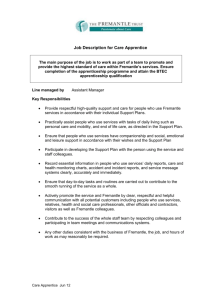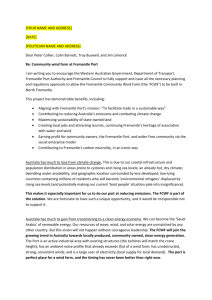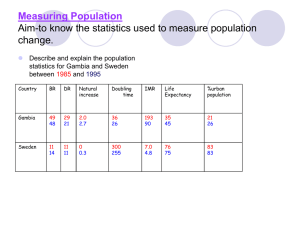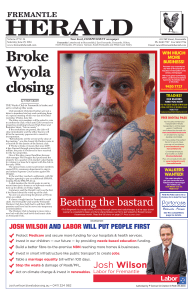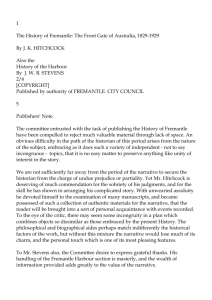City of Fremantle, Economic Development Strategy
advertisement
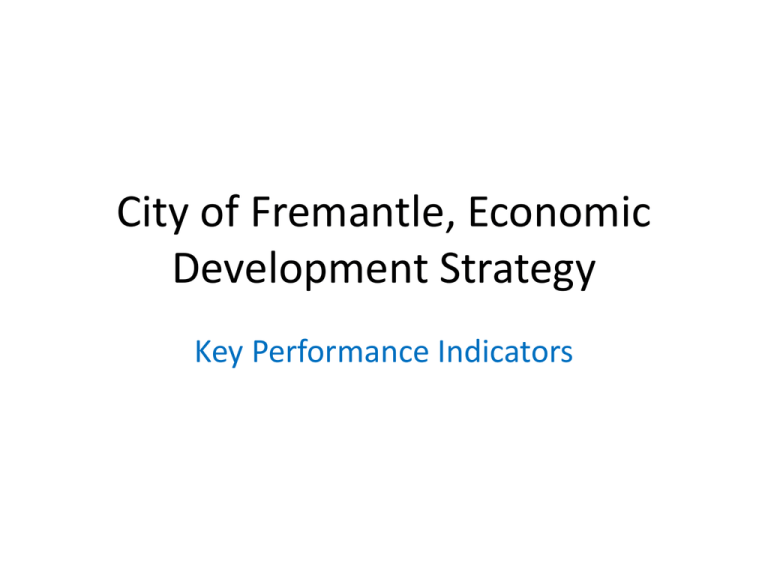
City of Fremantle, Economic Development Strategy Key Performance Indicators Purpose Monitor KPI’s identified in Economic Development Strategy Measure impact of Economic Development Strategy moving forward Identify areas of strength and weakness Types of Variables Economic measures (income, affordability etc.) Demographics, population, unemployment Investment and Business Methods of Measurement For each KPI, figures have been sought for the past 20 years Where figures are unavailable is due to Data not collected over the whole of the period Technology not available throughout the whole period Gross Local Product per capita Adjusted for inflation to 2007/2008 equivalent GLP Per Capita $140,000 $130,000 $120,000 $110,000 $100,000 Steady upward trend over the period $90,000 $80,000 $70,000 $60,000 Since 2007 trend has flattened, in part likely due to GFC $50,000 $40,000 Source: National Institue of Economic and Industry Research 2011 Population Fremantle Population 35,000 20 years of figures show gradual upward long term trend 30,000 25,000 20,000 10,000 5,000 Source: Australian Bureau of Statistics, Census of Population and Housing, 1991, 1996, 2001 and 2006 2010 2009 2008 2007 2006 2005 2004 2003 2002 2001 2000 1999 1998 1997 1996 1995 1994 1993 0 1992 Recent uptrend driven by North Fremantle development 15,000 1991 Approximately 1% per annum growth over past decade Fremantle Labour Force Census data collection began in 1999 23% growth over past decade Workers residence Cockburn (20%) Melville (18%) Fremantle (16%) Rockingham (6%) Canning (5%) Total Workforce Employed in Fremantle 40,000 35,000 30,000 25,000 20,000 15,000 10,000 5,000 0 1999 2000 2001 2002 2003 2004 2005 Source: National Institute of Economic and Industry Research 2006 2007 2008 2009 Fremantle Participation Rate Participation Rate Fremantle Participation Rate trended toward state average over the period 80% 75% 70% 65% 60% 2011 figures from different source, showing inflated results 55% Fremantle 50% Perth metroplitan area 45% Closing differential between Fremantle and Perth Metropolitan area 40% 1991 1996 2001 2006 Source: Australian Bureau of Statistics, Census of Population and Housing, 2006, 2001, 1996, and 1991 Unemployment Rate Unemployment Rate 20.0% Fremantle Steadily falling rate 18.0% Perth Metro Area WA 16.0% 14.0% 2011 likely to see flattening as full employment reached Australia 12.0% 10.0% 8.0% 6.0% 4.0% Reflects both gentrification or Fremantle and broader state trends 2.0% 0.0% 1991 1996 2001 2006 2011 Source: Australian Bureau of Statistics, Census of Population and Housing, 1991, 1996, 2001 and 2006 Department Education, Employment and Workplace Relations, Australian Regional Labour Markets, March Quarter 2011 Median Weekly Household Income ($) Wages $1,200 Census figures, adjusted for inflation to 2010 equivalent Strong upward trend over the period Increasing affluence in Fremantle $800 $ per week Median household size 2.2 people $1,000 $600 $400 $200 $0 1996 2001 Next census 2011 Source: Australian Bureau of Statistics, 1996, 2001, 2006 Census of Population and Housing 2007 Mean Taxable Income, adjusted for inflation $80,000 $70,000 $60,000 $50,000 $40,000 $30,000 Mean Taxable Income (Fremantle Residents) $20,000 Mean Taxable Income (WA Residents) $10,000 $0 1999 - 2000 2000 - 2001 2001 - 2002 2002 - 2003 2003 - 2004 2004 - 2005 2005 - 2006 2006 - 2007 2007 - 2008 2008 - 2009 Source: Australian Taxation Office, Taxation Statistics, 1999- 2009 Australian Taxation Office figures, adjusted for inflation to 2010 equivalent Steady real wage growth in taxable income across the City of Fremantle area Business and Technology Technology Business 36% of residents with access to broadband in 2006 Estimated 1800 active businesses in Fremantle Expected upward trend in next Census 83% of businesses have email Monitor in future 30% of businesses have a website Residents with a Bachelor's Degree (or higher) 30.0% Long term upward trend Fremantle 25.0% Perth Western Australia 20.0% Australia Fremantle above average 15.0% 10.0% Difference is increasing 5.0% 0.0% 1991 1996 2001 Source: Australian Bureau of Statistics, Census of Population and Housing, 1991, 1996, 2001 and 2006 2006 University of Notre Dame? Ratio: Median House Price/Median Household Income 14 12 10 8 6 4 2 0 40268 39903 39538 39172 38807 38442 38077 37711 37346 36981 36616 Housing affordability ratio doubled between 1996 – 2010 Some reversal since GFC Reflected in broader WA housing market to some extent 36250 35885 35520 35155 Net Lettable Area and Vacancy, Fremantle Commercial Industrial Retail Space Combined Vacancy Rate 800,000 20% 18% 700,000 16% 600,000 Area in M² 14% 500,000 12% 400,000 10% 8% 300,000 6% 200,000 4% 100,000 2% 0 0% 1990 1993 1997 2002 Source: Department of Planning Land Use Survey 1990, 1993, 1997, 2002 2007 survey figures currently being sought Slight fall in commercial space over period, looking for reversal in trend Increase in industrial space, mostly due to O’Connor Retail Space flat Fremantle Business Confidence 8% 70% 7% 60% 6% 50% 5% 40% 4% 30% 3% 20% Businesses expecting an increase in profit over next 12 months Business Intending to Continue Operation 10% 2% 1% RBA Cash Rate 0% 0% Aug-08 Feb-09 Aug-09 Feb-10 Source: Asset Research Business Climate Survey, 2008 - 2010 Profitability & confidence drop during “GFC” Profits have remained flat, confidence is shaky RBA has resumed tightening cycle Next survey due in December Aug-10 RBA Cash Rate Business Confidence 80% Indicators to monitor in the future - Institutional Membership - Fremantle Chamber of Commerce - Experience Perth - Value of non-residential building applications - People Employed in Research and Technical Services
